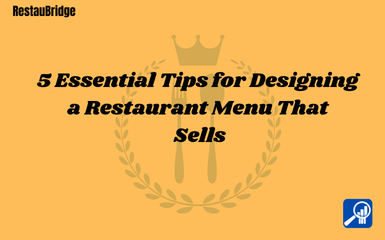5 Essential Tips for Designing a Restaurant Menu That Sells
A well-designed menu is one of the most powerful marketing tools for your restaurant. It not only showcases your offerings but also influences customer decisions, enhancing their dining experience. A strategically designed menu can increase sales, promote high-margin dishes, and keep customers coming back for more. Here are five essential tips for designing a restaurant menu that sells:

1. Keep It Simple and Focused
While it might be tempting to offer a vast range of dishes, a cluttered menu can overwhelm customers and slow down decision-making. Focus on your signature dishes and bestsellers. Keep the menu concise with a mix of options to appeal to different tastes but avoid excessive choices that may confuse the customer. A well-curated menu makes it easier for your customers to choose, increasing their likelihood of ordering.
2. Use Descriptive, Tempting Language
Menu descriptions can make a huge difference in customer perception. Use descriptive and appetizing language to entice your customers, highlighting the key ingredients and preparation style. For instance, instead of simply listing “Grilled Chicken,” say, “Juicy grilled chicken marinated in a blend of fresh herbs and served with a smoky chipotle sauce.” Descriptive wording makes the dish sound irresistible and adds value to the meal in the customer’s mind.
3. Organize Your Menu with Logical Categories
Ensure your menu is easy to navigate by grouping similar items together under clear, logical categories. Divide your menu into sections such as appetizers, mains, desserts, and beverages. Make sure the layout is clean and uncluttered so customers can quickly find what they're looking for. Consider grouping your best or most profitable dishes at the beginning of each section, as customers often start by looking at the first few items.
4. Highlight Signature and High-Margin Items
To maximize profits, highlight your signature dishes or high-margin items that you want to sell more of. You can do this by using different font styles, boxes, or colors to draw attention to these items. Placing them at the top of the menu or near the middle—where eyes typically land—can boost sales for these items. This strategic placement encourages customers to consider these dishes first.
5. Maintain a Balanced Price Range
Price plays a significant role in the customer’s decision-making process. Ensure your menu offers options at various price points to cater to different budgets. Avoid making all your items extremely high-end or too cheap. A balanced price range gives customers a sense of control over their choices, and it ensures that no one feels excluded based on their budget. Offering a few affordable options alongside premium items can also create a perception of value for money.
Conclusion
Your restaurant menu is more than just a list of items; it's a tool for driving sales and enhancing the customer experience. By keeping your menu simple, using descriptive language, organizing items logically, and highlighting signature dishes, you can influence customer choices and increase sales. A well-thought-out menu design can be the key to a successful dining experience, boosting customer satisfaction and restaurant profitability.
If you need professional help in designing your restaurant menu, Restaubridge offers expert services that can help you create a menu that not only looks great but also drives sales. Contact us today!


Post a Comment